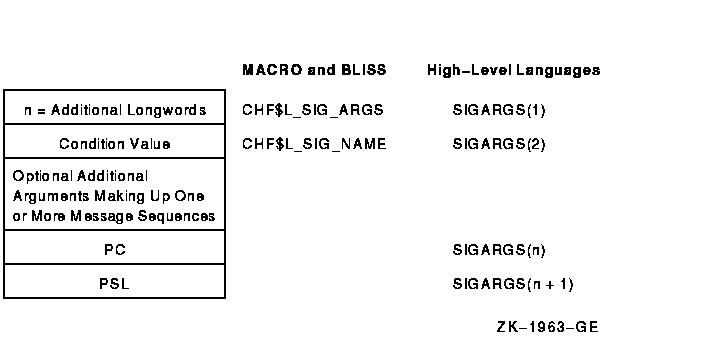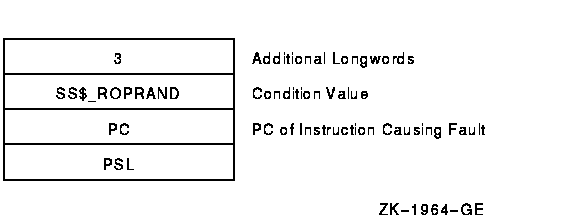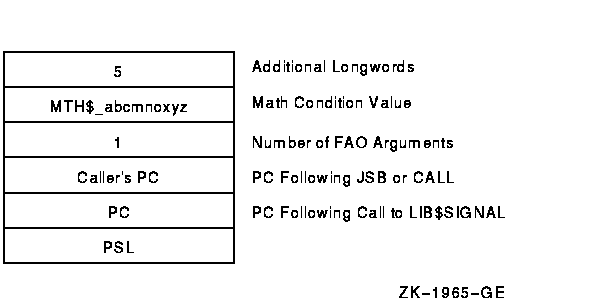Software > OpenVMS Systems > Documentation > 731final > 5841 HP OpenVMS Systems Documentation |
OpenVMS Programming Concepts Manual
9.7 Argument List Passed to a Condition HandlerOn VAX systems, the argument list passed to the condition handler is constructed on the stack and consists of the addresses of two argument arrays, signal and mechanism, as illustrated in Section 9.8.2 and Section 9.8.3. On Alpha systems, the arrays are set up on the stack, but any argument is passed in registers. On VAX systems, you can use the $CHFDEF macro instruction to define the symbolic names to refer to the arguments listed in Table 9-9.
On Alpha systems, you can use the $CHFDEF2 macro instruction to define the symbolic names to refer to the arguments listed in Table 9-10.
9.8 SignalingSignaling can be initiated when hardware or software detects an exception condition. In either case, the exception condition is said to be signaled by the routine in which it occurred. If hardware detects the error, it passes control to a condition dispatcher. If software detects the error, it calls one of the run-time library signal-generating routines: LIB$SIGNAL or LIB$STOP. The RTL signal-generating routines pass control to the same condition dispatcher. When LIB$STOP is called, the severity code is forced to severe, and control cannot return to the routine that signaled the condition. See Section 9.12.1 for a description of how a signal can be dismissed and how normal execution from the point of the exception condition can be continued. When a routine signals, it passes to the OpenVMS Condition Handling facility (CHF) the condition value associated with the exception condition, as well as optional arguments that can be passed to a condition handler. The CHF uses these arguments to build two data structures on the stack:
These two vectors become the arguments that the CHF passes to condition handlers. These argument vectors are described in detail in Section 9.8.2 and Section 9.8.3. After the signal and mechanism argument vectors are set up, the CHF searches for enabled condition handlers. A condition handler is a separate routine that has been associated with a routine in order to take a specific action when an exception condition occurs. The CHF searches for condition handlers to handle the exception condition, beginning with the primary exception vector of the access mode in which the exception condition occurred. If this vector contains the address of a handler, that handler is called. If the address is 0 or if the handler resignals, then the CHF repeats the process with the secondary exception vector. Enabling vectored handlers is discussed in detail in the OpenVMS Calling Standard. Because the exception vectors are allocated in static storage, they are not generally used by modular routines. If neither the primary nor secondary vectored handlers handle the exception condition by continuing program execution, then the CHF looks for stack frame condition handlers. It looks for the address of a condition handler in the first longword of the routine stack frame on VAX systems, or in the procedure descriptor (in which the handler valid bit is set) for the routine stack frame on Alpha systems where the exception condition occurred. At this point, several actions are possible, depending on the results of this search:
The OpenVMS Condition Handling facility searches for and calls condition handlers from each frame on the stack until the frame pointer is zero (indicating the end of the call sequence). At that point, the CHF calls the vectored catchall handler, which displays an error message and causes the program to exit. Note that, normally, the frame containing the stack catchall handler is at the end of the calling sequence or at the bottom of the stack. Section 9.9 explains the possible actions of default and user condition handlers in more detail. Figure 9-5 illustrates a stack scan for condition handlers in which the main program calls procedure A, which then calls procedure B. A stack scan is initiated either when a hardware exception condition occurs or when a call is made to LIB$SIGNAL or LIB$STOP. Figure 9-5 Sample Stack Scan for Condition Handlers 
9.8.1 Generating Signals with LIB$SIGNAL and LIB$STOPWhen software detects an exception condition, the software normally calls one of the run-time library signal-generating routines, LIB$SIGNAL or LIB$STOP, to initiate the signaling mechanism. This call indicates to the calling program that the exception condition has occurred. Your program can also call one of these routines explicitly to indicate an exception condition. You can signal a condition code by invoking the run-time library procedure LIB$SIGNAL and passing the condition code as the first argument. (The OpenVMS RTL Library (LIB$) Manual contains the complete specifications for LIB$SIGNAL.) The following statement signals the condition code contained in the variable STATUS:
When an error occurs in a subprogram, the subprogram can signal the appropriate condition code rather than return the condition code to the invoking program unit. In addition, some statements also signal condition codes; for example, an assignment statement that attempts to divide by zero signals the condition code SS$_INTDIV. When your program wants to issue a message and allow execution to continue after handling the condition, it calls the standard routine, LIB$SIGNAL. The calling sequence for LIB$SIGNAL is the following:
Only the condition-value argument must be specified; other arguments are optional. A description of the arguments is as follows:
When your program wants to issue a message and stop execution unconditionally, it calls LIB$STOP. The calling sequence for LIB$STOP is as follows:
Only the condition-value argument must be specified; other arguments are optional. The condition-value argument is an OpenVMS 32-bit condition value. The condition-value argument is an unsigned longword that contains this condition value. The number-of-arguments argument, if specified, contains the number of FAO arguments that are associated with condition-value. The optional number-of-arguments argument is a signed longword integer that contains this number. If omitted or specified as zero, no FAO arguments follow. The FAO-argument argument is an optional FAO (formatted ASCII output) argument that is associated with the specified condition value. The condition-value argument indicates the condition that is being signaled. However, LIB$STOP always sets the severity of condition-value to SEVERE before proceeding with the stack-scanning operation. The FAO arguments describe the details of the exception condition. These are the same arguments that are passed to the OpenVMS Condition Handling facility as part of the signal argument vector. The system default condition handlers pass them to SYS$PUTMSG, which uses them to issue a system message. Unlike most routines, LIB$SIGNAL and LIB$STOP preserve R0 and R1 as well as the other registers. Therefore, a call to LIB$SIGNAL allows the debugger to display the entire state of the process at the time of the exception condition. This is useful for debugging checks and gathering statistics. The behavior of LIB$SIGNAL is the same as that of the exception dispatcher that performs the stack scan after hardware detects an exception condition. That is, the system scans the stack in the same way, and the same arguments are passed to each condition handler. This allows a user to write a single condition handler to detect both hardware and software conditions. For more information about the RTL routines LIB$SIGNAL and LIB$STOP, see OpenVMS RTL Library (LIB$) Manual. 9.8.2 Signal Argument VectorSignaling a condition value causes both VAX and Alpha systems to pass control to a special subprogram called a condition handler. The operating system invokes a default condition handler unless you have established your own. The default condition handler displays the associated error message and continues or, if the error is a severe error, terminates program execution. The signal argument vector contains information describing the nature of the hardware or software condition. Figure 9-6 illustrates the open-ended structure of the signal argument vector, which can be from 3 to 257 longwords in length. The format of the signal argument array and the data it returns is the same on VAX systems and Alpha systems, with the exception of the processor status (PS) returned on Alpha systems and the processor status longword (PSL) returned on VAX systems. On Alpha systems, it is the low-order 32 bits of the PS. On Alpha systems, CHF$IS_SIG_ARGS and CHF$IS_SIG_NAME are aliases for CHF$L_SIG_ARGS and CHF$L_SIG_NAME, as shown in Figure 9-6, and the PSL field for VAX systems is the processor status (PS) field for Alpha systems. Figure 9-6 Format of the Signal Argument Vector 
Fields of the Signal Argument Vector
The formats for some conditions signaled by the operating system and the run-time library are shown in Figure 9-7 and Figure 9-8. These formats are the same on VAX systems and Alpha systems, except for the PSL, or on Alpha systems, the PS register. Figure 9-7 Signal Argument Vector for the Reserved Operand Error Conditions 
Figure 9-8 Signal Argument Vector for RTL Mathematics Routine Errors 
The caller's PC is the PC following the calling program's JSB or CALL to the mathematics routine that detected the error. The PC is that following the call to LIB$SIGNAL. 9.8.3 VAX Mechanism Argument Vector (VAX Only)On VAX systems, the mechanism argument vector is a 5-longword vector that contains all of the information describing the state of the process at the time of the hardware or software signaled condition. Figure 9-9 illustrates a mechanism argument vector for VAX systems. Figure 9-9 Format of a VAX Mechanism Argument Vector 
Fields of the VAX Mechanism Argument Vector
|